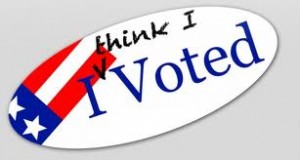 Chad Brown of Ankeny, “the co-chairman of the Polk County Republican Party, has resigned and changed his party registration to independent, saying the GOP has become too conservative and is condoning “hateful” rhetoric,” reported Kathie Obradovich, political columnist for the Des Moines Register, on Tuesday. The flight of voters to no preference (a.k.a. independent) is not new in Iowa, although Brown may be the first GOP party chair to switch in a while, and it’s news.
Chad Brown of Ankeny, “the co-chairman of the Polk County Republican Party, has resigned and changed his party registration to independent, saying the GOP has become too conservative and is condoning “hateful” rhetoric,” reported Kathie Obradovich, political columnist for the Des Moines Register, on Tuesday. The flight of voters to no preference (a.k.a. independent) is not new in Iowa, although Brown may be the first GOP party chair to switch in a while, and it’s news.
The flight to no preference is significant. Here are the Secretary of State’s August active voter registration numbers by congressional district.
First District: Democratic: 162,447; Republican: 136,290; No Preference: 192,715.
Second District: Democratic: 170,096; Republican: 138,517; No Preference: 182,097.
Third District: Democratic: 157,375; Republican: 164,176; No Preference: 157,076.
Fourth District: Democratic: 127,457; Republican: 178,158; No Preference: 174,307.
Iowa Total: Democratic: 617,375; Republican: 617,141; No Preference: 706,195.
During the 2012 general election campaign, the author spoke to thousands of voters in their communities and at their doorsteps, and the moniker of “no preference” is inaccurate. Voters do have a preference, although it is not based in a political party or the kind of politicized talking points that often characterize a campaign. Voters, in the majority of cases, want to do what they think is right, emphasis on thinking. Most who planned to vote gave careful consideration to the candidates in specific races. In the majority of cases, party affiliation was less important than whether the candidate would perform well in elected office.
Our campaign door knocked enough to meet voters and have multiple conversations with them over the course of the eight month campaign. It was an opportunity to see how the decision-making process went and how choices were made. Our campaign was in the second congressional district, and support for Rep. Dave Loebsack solidified first, as he is well liked in the district. Next was a reluctant choice for President Obama, and it was clear many voters did not like their choices for president. In the state house race in which I was working, people said they hadn’t decided, but I think they were just being polite at their door as the Republican candidate won 56.3 percent to 43.5 percent.
Perhaps most telling was conversations with poll workers during the June 5, 2012 primary election. I visited every polling place in our district on election day and to a person the poll workers said voter turnout was low and they expected it to be low. I asked why. The answers varied, but the consistent theme was that people did not want to be seen by friends and neighbors at the polls as a registered Democrat or Republican. This was particularly the case in mostly rural Cedar County, which is part of our house district and arguably a bellwether county.
The role of politics in daily life had been minimized by many voters I met. Politics mattered, but in a busy life, voters didn’t want to spend a lot of energy on it until the election was imminent, or a particular issue percolated to the surface of their lives.
There are exceptions to everything, but the upshot is that candidates will do better if they figure a way to gain favorable consideration among all registered voters, including members of the opposing party and so-called “no preference” voters. This is increasingly important the further down the ticket a race falls.
There are ideologues throughout the political spectrum, but in the wake of the 2006 and 2008 general elections, their time came in 2010, and is now hopefully receding. The resignation of the Polk County GOP co-chair is just one more example.



This raises the question: how hard is it to run as an independent or a third-party candidate in Iowa? It seems that party brands are not very valuable right now. I know Iowa has had other parts in the past, in the 19th century….
LikeLike
Nathanael,
Thanks for reading this post and commenting about it.
Iowa has a progressive history, with a number of third parties, such as the Liberal Republican Movement, the Farmers Movement, the Greenback Movement, the Populist Movement and the Progressive Movement. Fred Haynes wrote a book about them titled, “Third Party Movements since the Civil War with Special reference to Iowa,” published in 1916. The trend of these movements was to eventually assimilate into the major parties over time.
To me, the most salient characteristic among voters was to be individualistic about their approach to voting for a candidate. Individualistic vs. party oriented. With the explosion of information available through high speed Internet, people have direct access to candidates, and information about them, and no longer have much use for political parties, except to organize big events. If a third party candidate had a compelling (to voters) personal story or wide spread name recognition, they might stand a chance.
In terms of running for office, that is something of a barrier to entry because the two major parties call most of the campaign related shots for media and other types of exposure. I’d say it would be pretty hard to run as an independent.The political parties are fractured, Rs more than Ds, and one more splinter interest seems unlikely to gain traction.
Thanks again for reading and commenting.
Regards, Paul
LikeLike